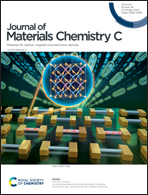Ion diffusion coefficients in poly(3-alkylthiophenes) for energy conversion and biosensing: role of side-chain length and microstructure†
Abstract
Conductive polymers are promising materials as active elements for energy storage and conversion devices due to mixed ion–electron conduction. The ion diffusion coefficient is a relative measure of the efficacy of ion transport, allowing for comparison between materials and electrochemical conditions. In this work, diffusion coefficients of hexafluorophosphate (PF6−) counterions in poly(3-alkylthiophene) (P3AT) materials are measured as a function of both side-chain length and microstructure using electrochemical impedance spectroscopy (EIS). For semi-crystalline films, the diffusion coefficient is found to be anomalous and nearly independent of applied electrochemical potential. The anomalous behavior of diffusion indicates that spin casting yields compact films with an enthalpic barrier to ion transport, attributed to ionic trapping. Diffusion coefficient values ∼10−11 cm2 s−1 were measured for all films, indicating interchain spacing, in the absence of strong intermolecular interactions with the electrolyte, is not a viable design strategy to control ion transport. For the prototypical system of poly(3-hexylthiophene), we observe almost no potential dependence in ion transport for regioregular and regiorandom films of comparable molecular weight, with both exhibiting anomalous diffusion. Alternatively, changing the microstructure of poly(3-hexylthiophene) to a mostly amorphous, ion-imprinted structure yields ∼500× increase in the diffusion coefficient to ∼2 × 10−8 cm2 s−1 at 0.8 V vs. Ag/Ag+ with behavior closer to ordinary diffusion. Collectively, these results indicate new insight into ion transport in conductive polymers, where ionic trapping effects can be mitigated through electrodeposition protocols over post-synthesis processing (i.e. spin coating).



 Please wait while we load your content...
Please wait while we load your content...